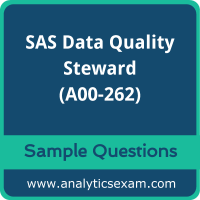01. Assume these items are created for the Supplier repository:
- A row-based business rule called Monitor for Nulls
- A set-based business rule called Percent of Verified Addresses
- A group-based rule called Low Product Count
- A task based on the row-based, set-based, and group-based rules called Monitor Supplier Data
Which one can you apply in a Data Monitoring node in a data job?
a) row-based business rule called Monitor for Nulls
b) set-based business rule called Percent of Verified Addresses
c) task based on the row-based, set-based, and group-based rules called Monitor Supplier Data
D) group-based rule called Low Product Count
02. Which definition in the Quality Knowledge Base would be appropriate for selecting specific diagnosis information from a physician's unstructured patient treatment notes?
a) Extraction definition
b) Parse definition
c) Match definition
d) Identification Analysis definition
03. For a data job to serve as a real-time data service, the External Data Provider node is a required first node. For a process job to serve as a real-time process service, how is information passed in to the process flow?
a) The Process Flow External Data node from the Utilities grouping is used to pass data in to a process job that will serve as a process service.
b) The Process Flow Work Table Reader node from the Utilities grouping is used to pass data in to a process job that will serve as a process service.
c) The Settings tab of the process job is used to define the input variables.
d) The Variables tab of the process job is used to define the input variables.
04. You need to create a new business rule. Which two methods can you use to access the Business Rules Manager in DataFlux Data Management Studio?
(Choose two.)
a) From the Tools menu, select Business Rules Manager and then select a repository.
b) From the Folders riser bar, select a repository and then select New -> Business Rule.
c) From the Tools menu, select New -> Business Rule.
d) From the Information riser bar, select the Monitor item and then select a repository.
05. What are the valid types of symbols you can declare in Expression Engine Language (EEL)?
a) integer, string, real, Boolean, date, file
b) integer, string, real, Boolean, date
c) integer, string, real, Boolean, date, file, regex
d) integer, string, real, Boolean, date, file, regex, bluefusion
06. How do you connect to an existing repository in DataFlux Data Management Studio?
a) from the Administration riser bar
b) from the Folders riser bar
c) from the Data riser bar
d) You cannot connect to an existing repository.
07. In a process job, which node do you use to retrieve and assign variables for nested jobs?
a) Global Get/Set node
b) Global Retrieve/Assign node
c) Local Retrieve/Assign node
d) Local Get/Set node
08. Where do you create a macro in DataFlux Data Management Studio?
a) In the Data Management Studio Options, select the Macro option.
b) From the Folders riser bar, select a repository and then select New Macro.
c) From the Information riser bar, select the Macro Files item.
d) From the Administration riser bar, select the Macro Files item.
09. Which process job node allows you to define the number of machine CPU processors to use if available?
a) Fork Node
b) Parallel Iterator
c) Event Listen
d) If Then
10. You need to review the Monitoring Report to see the data values that triggered a business rule. Where do you access the Monitoring Report in DataFlux Data Management Studio?
a) On the Tools menu, select Monitoring Report and then select the appropriate repository.
b) On the Tools menu, select Business Rules Manager and then select the appropriate repository.
c) On the Information riser bar, select the Monitor item and then select the appropriate repository.
d) On the Information riser bar, select the Monitor item, select the appropriate repository, then click link for Monitoring Report.
 Welcome! Preparing for the SAS Data Quality using DataFlux Data Management Studio (A00-262) certification exam can be a daunting task, but we're here to make it easier for you. Here are the sample questions that will help you become familiar with the SAS A00-262 exam style and structure. We encourage you to try our Demo SAS Data Quality Steward Certification Practice Exam to measure your understanding of the exam structure in an environment that simulates the actual test environment.
Welcome! Preparing for the SAS Data Quality using DataFlux Data Management Studio (A00-262) certification exam can be a daunting task, but we're here to make it easier for you. Here are the sample questions that will help you become familiar with the SAS A00-262 exam style and structure. We encourage you to try our Demo SAS Data Quality Steward Certification Practice Exam to measure your understanding of the exam structure in an environment that simulates the actual test environment.